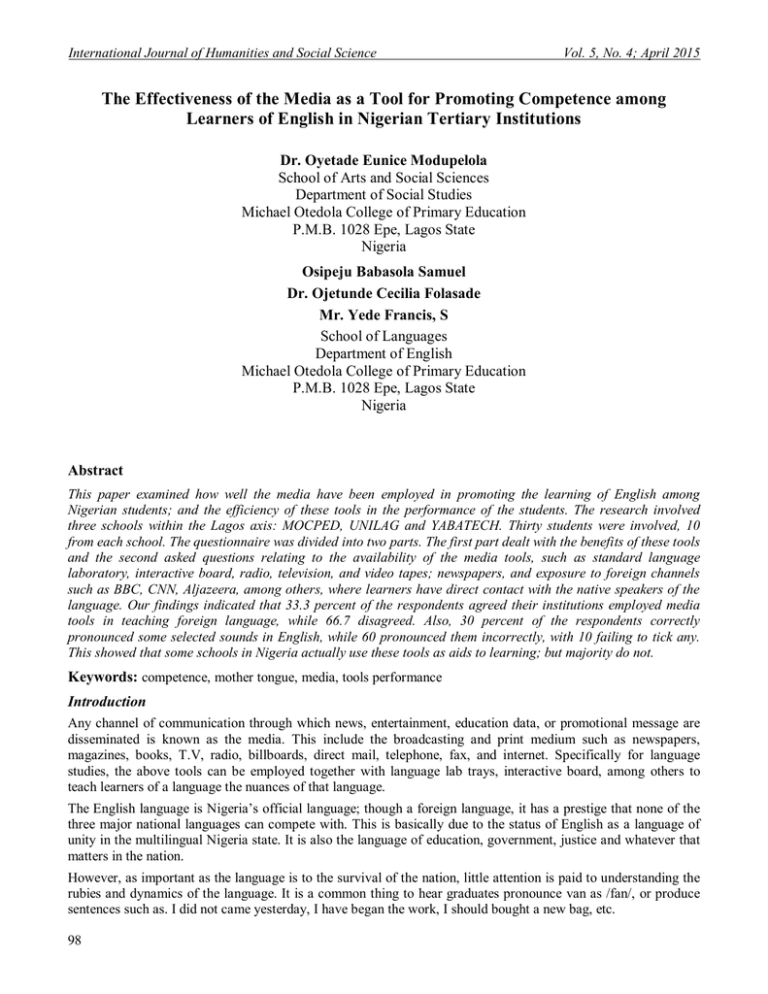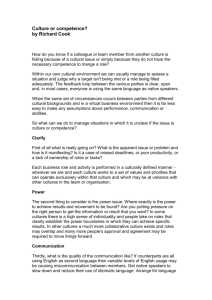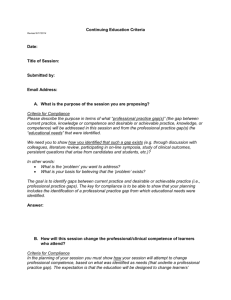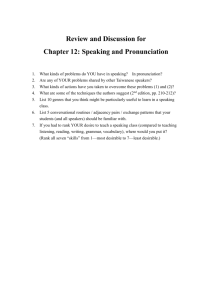The Effectiveness of the Media as a Tool for Promoting... Learners of English in Nigerian Tertiary Institutions
advertisement

International Journal of Humanities and Social Science Vol. 5, No. 4; April 2015 The Effectiveness of the Media as a Tool for Promoting Competence among Learners of English in Nigerian Tertiary Institutions Dr. Oyetade Eunice Modupelola School of Arts and Social Sciences Department of Social Studies Michael Otedola College of Primary Education P.M.B. 1028 Epe, Lagos State Nigeria Osipeju Babasola Samuel Dr. Ojetunde Cecilia Folasade Mr. Yede Francis, S School of Languages Department of English Michael Otedola College of Primary Education P.M.B. 1028 Epe, Lagos State Nigeria Abstract This paper examined how well the media have been employed in promoting the learning of English among Nigerian students; and the efficiency of these tools in the performance of the students. The research involved three schools within the Lagos axis: MOCPED, UNILAG and YABATECH. Thirty students were involved, 10 from each school. The questionnaire was divided into two parts. The first part dealt with the benefits of these tools and the second asked questions relating to the availability of the media tools, such as standard language laboratory, interactive board, radio, television, and video tapes; newspapers, and exposure to foreign channels such as BBC, CNN, Aljazeera, among others, where learners have direct contact with the native speakers of the language. Our findings indicated that 33.3 percent of the respondents agreed their institutions employed media tools in teaching foreign language, while 66.7 disagreed. Also, 30 percent of the respondents correctly pronounced some selected sounds in English, while 60 pronounced them incorrectly, with 10 failing to tick any. This showed that some schools in Nigeria actually use these tools as aids to learning; but majority do not. Keywords: competence, mother tongue, media, tools performance Introduction Any channel of communication through which news, entertainment, education data, or promotional message are disseminated is known as the media. This include the broadcasting and print medium such as newspapers, magazines, books, T.V, radio, billboards, direct mail, telephone, fax, and internet. Specifically for language studies, the above tools can be employed together with language lab trays, interactive board, among others to teach learners of a language the nuances of that language. The English language is Nigeria’s official language; though a foreign language, it has a prestige that none of the three major national languages can compete with. This is basically due to the status of English as a language of unity in the multilingual Nigeria state. It is also the language of education, government, justice and whatever that matters in the nation. However, as important as the language is to the survival of the nation, little attention is paid to understanding the rubies and dynamics of the language. It is a common thing to hear graduates pronounce van as /fan/, or produce sentences such as. I did not came yesterday, I have began the work, I should bought a new bag, etc. 98 ISSN 2220-8488 (Print), 2221-0989 (Online) ©Center for Promoting Ideas, USA www.ijhssnet.com As noted by Signes (2001), it is a privilege to have media tools to teach foreign language to students of this generation. According to him, years before, learners did not have the opportunity and as a result, faced different challenges. He notes that the media would ensure interaction with the native speakers of the language, features and generic conventions, a first step for developing a critical attitude. This first step, Christie (1985:22) argues that “learning the genres of one’s culture is both part of entering into it with understanding, and part of developing the necessary ability to change it.” Review of Studies The subject of language teaching and learning and the end result of this process – competence in language usage and improved academic performance, should be major concern of language educators and linguists. This is because language is central to learning and to life itself (Oyetunde and Muodumogu 1990:1). The effective teaching and learning of language is believed to be the success of education generally, as it is equally believed that educational failure is basically a linguistics failure (Akinwunmi and Oyetunde 2006:37). Based on this, attention is drawn, in recent years, to the close relationship between language competence and educational achievement, hence, emphasis is laid on the need to improve English teaching and learning through the use of teaching aids. Much of the teaching that goes on in the primary and secondary schools cannot be done in the abstract form. Teaching aids are meant to stimulate pupils interest in the lesson for meaningful learning to take place. Ogunjimi and Okuntade (2009:87) are of the opinion that effective usage of media is a vital tool for improved learning productivity as it also facilitates collaboration with the global world through advancement in technology, new resources capable of presenting information incredibly in terms of speed and accuracy are created while capacity to store information is amazing in this age of information communication technology (ICT), there is a drastic increase in the potential of sharing information and knowledge across the globe. Media and communication technologies have become one of the indispensable tools in achieving English language competence. Soo Kim (2012) in exploring communication competence and psychological health of young Korean immigrants in the U.S. revealed that adults can help young learners achieve language competence (i.e. mastering of English) by educating them to broaden interpersonal network and guiding them to good quality media in the target language. The ability to understand and interpreted the target language’s radio, television and print media are signals of the learner’s competence in the language (Modern Language Association). Signes (2001:123) opines that the present generation of foreign learners are privileged in their knowledge of mass media and as such if they are taught how to analyze mass media products, they are being helped to develop a whole range of individual, practical, social, cultural and intellectual skills which they will need in the future. For effective teaching of any foreign language, Signes (2012;127) therefore suggests that teachers should engage students in exercises having a TV set, or a tape recorder, computer or printed material in the classroom on one hand; he suggests a set of exercises in which the mass media are used as reference, as a starting point, as a prompt and effective motivation for initiating interaction in the foreign language on the other hand. This is believed will promote competence among learners of foreign languages in general and the English language in particular. Methods of Data Collation and Analysis The effects and efficiency of media tools on the learning of English as a second language is a board research topic, and in order to covered a wider scope of the study, schools were chosen at random and a survey design format for observation was self- administered. There are several higher institutions in Lagos state, Nigeria, but the three selected for this study were: The University of Lagos State Yaba college of Technology Michael Otedola College of Technology. Ten students were selected from each school through simple random sampling. The respondents were all in their second year, undergoing different courses. However, there is a common course titled general course in English language. The essence is to improve their communicative competence in the language we all have adopted as official language. This course is the basis of this study. 99 International Journal of Humanities and Social Science Vol. 5, No. 4; April 2015 Out of the 30 students sampled from the three institutions, 18 were male, while 12 were female, 21 were between ages 18 – 20 while 9 were between ages 21-30. Out of the thirty students involved in this research, 18 agreed they know and have seen what a language lab is. This shows 60% of the respondents. On the other hand, 8 (16.7), disagreed, while 04 (13.3) were undecided. Also on a related question, on whether they knew if their institutions have a language lab. 6 (20%) was sure their institutions have, 20 (66.7%) disagreed, while 4 (13.3%) were undecided. Also, in teaching listening skills, 20 (66.7%) disagreed their tutors use TV and radio so as to listen and watch native speakers in the use of their language; while 10 (33.3%) agreed they used these tools for learning. Also on pronunciation, 5 (16.6%) agreed their teachers emphasized spoken form of the language with 25 (83.4%) disagreeing. Finally, 9 (30%) respondents got the pronunciation of these sounds correctly,/Ʒ/, /dƷ/, /Ɵ/, while 18 (60%) got it wrong and 3 (10%), were undecided. The table below shows the summary of the analyses: Questions You have seen a language lab before Your institutions have language laboratory Teachers use TV and radio in teaching Teachers emphasized pronunciation Pronunciation of the sounds /Ʒ/, /dƷ/, /Ɵ/, A 18 06 10 05 09 D 08 20 20 25 18 U 04 04 03 Total 30 30 30 30 30 Percentage 60, 26.7, 13.3 20, 667, 13.3 33.3, 66.7 16.6, 83.4 30, 60, 10 The analyses and table that followed, without doubt, are a true reflection of the situation in our higher institutions in Nigerian, as most schools do not have facilities to teach foreign language. However, where these facilities are available (e.g. MOCPED and UNILAG), they are restarted to students taking English and other foreign languages. Some institutions even locked up these facilities, due to non-availability of competent hands, allowing the tool to waste away. UNILAG has a language lab, but as the as may be, it could not go round all the students of the institution. The facilities could not even go round students studying English language alone not to talk of students from all the departments in the college taking English as a compulsory course. MOCPED also boasts of one of the best newest digital labs in the country. Unlike UNILAG lab, MOCPED’s included an electronic interactive board. This was, however, installed after the National University Commission (NUC) denied it accreditation of English, as one of the degree programmes she runs in affiliation with the Ekiti State University. Before the installation of the lab, it boasted of an outdated lab that was rejected by the NUC. But the fact remains that the facilities can’t go round all the students who take the general English course. Findings From the study, it is obvious that as vital as the English language is, Nigeria has not given it much attention as it requires. This ranges from shortage of teaching staff, incompetent hands, inadequate training for academic staff, outdated language lab, and where available, not put to good use. Also, other media tools such as internet, television, radio, tapes and other cable stations including books, that afford the learners opportunity of direct contact with native speakers of the language are either unbuildable, and where available not accessible as well as expensive. Recommendation It is a cheer privilege for this generation to have media tools to aid learning. This because they help the tutor to be efficient and effective in the classroom. They can also help students maximize their time by speaking and practicing speaking the language more often. The instructor can also record the performance of students and burn into CDs for playback and immediate assistance. Therefore, to save this generation from deficiency in the language we term object of interaction and survival as a nation, we recommend that: Schools should make available media tools, as it will enhance the teaching of the second language These tools, where available, be used for the benefit of the students 100 ISSN 2220-8488 (Print), 2221-0989 (Online) ©Center for Promoting Ideas, USA www.ijhssnet.com Some students are still being influenced by their mother tongue negatively; this is due to ineffective use of these tools. Academic staff should also be trained so as to effectively use these tools. Conclusion Multimedia as proper means of enhancing international intelligibility in the learners foreign language use is strongly suggested by his study. Multimedia aptly refers to the integration and interaction of different types of technology to enhance instruction. The suitability of multimedia in oral English learning and teaching has been tested in various studies by Elliot (2000) &Gluslandi (1994). Multimedia could be utilized to capture target language situations through packaging authentic and pseudo-authentic language environment in software like CDROMS for use in the teaching/learning situations (Reeder et al., 2001). The use of video in teaching Oral English enhances students viewing and acquiring sounds and speech organs movement and contact physically. Conian (2001) asserts that video teaching provides vivid advantage of learning language directly via cultural, context and discourse mileu. This eventually leads to positive acquisition of coordinate bilingual status. Furthermore, video presentation enables the learners to get positive cues from L1 speakers of the target language. This is made possible by the dynamics of interactions during the observations of the native speakers in natural language use setting; utilizing different accents, registers and paralinguistic cues. Eventually, this leads to getting clues from what the speakers say or is going to say. The positive use of multimedia in teaching oral skill in the target language has been corroborated in the studies of Altman (1990), Conian (2001), Abimbade and Ogar (2005), Models are also veritable means of productive oral English teaching. This could be through viewing of L1 speakers on video or through physical interaction with a resource person who has acquired native speaker proficiency or and actual native speaker of the target language. These will be listened to and the students will be made to interact with them, thus enabling them to acquire the right pronunciation and speech pattern unconsciously. This practice and process should be continuous and consistent until a noticeable improvement is brought to bear in the students. References Akinwunmi, O.O &Ojetunde, C.F. (2006). The Role of Instructional materials/Resources in Effective Teaching and Learning of English Language in Orjinta, C.O., Idowu, Methodologies in the Arts and Social Sciences. Lagos: Lolaid Enterprises. pp. 37-48 Modern Language Association: Foreign Languages and Higher Education: New Structures a changed World. www.mla.org/fireport Ogunjimi, M.O. &Okuntade, J.O (2009). Identifying the Strategy of Utilizing Instructional Technology for Effective Distance Learning in Sandwish Education Review (SER) vol. 10 pp.82-88 Oyetunde, T.O. &Muodumogu, C.A. (1999). Effective English Teaching in Primary and Secondary Schools. Jos: University of Jos: pp1-2 Signes, C.G. (2001). Language Teaching and Media Literacy in Ferrer, H. et al. Teaching English in a Spanish setting. Valencia: Universitat de Valencia pp. 123-136 Soo, Kim, Y. (2012). Exploring Communication Competence and Psychological Health: A Study of CrossCultural Adaptation among Young Korean Immigrants in the U.S. Journal of Intercultural Communication. Issue 28 URL:http/www.immi.se/intercultural 101






